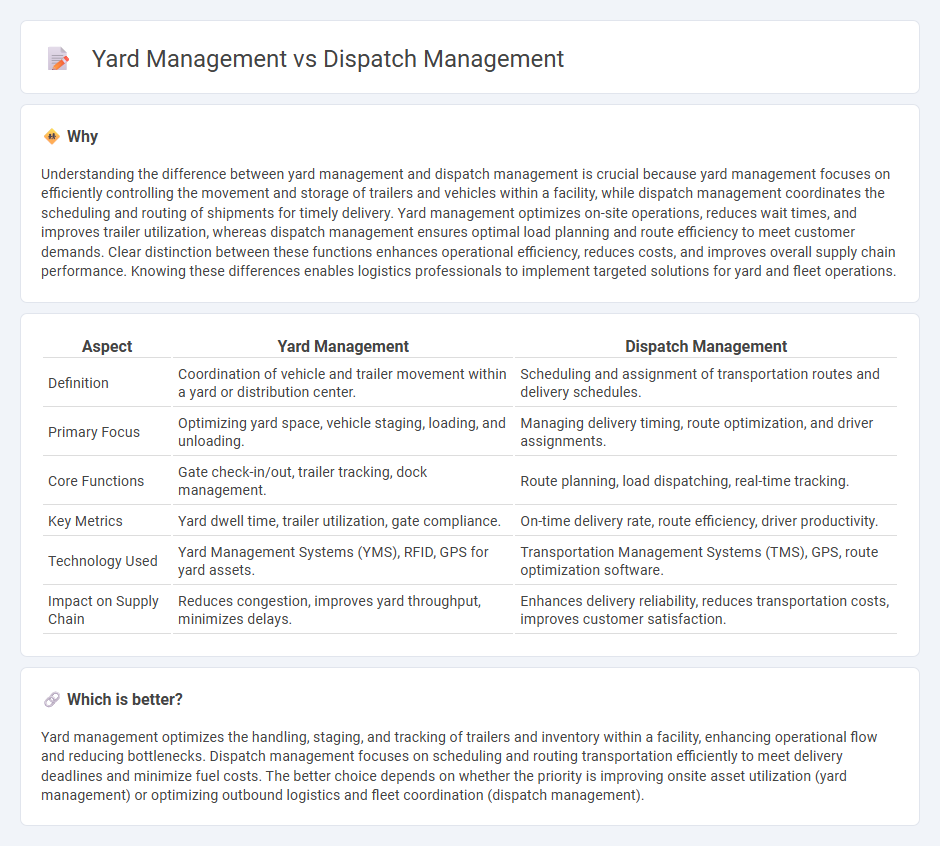
Yard management focuses on controlling the movement and storage of trailers and cargo within a facility's yard, optimizing space utilization and ensuring efficient loading and unloading processes. Dispatch management coordinates the scheduling and routing of outbound shipments, aiming to enhance delivery times and resource allocation. Discover how integrating yard and dispatch management can transform your logistics operations and boost overall supply chain efficiency.
Why it is important
Understanding the difference between yard management and dispatch management is crucial because yard management focuses on efficiently controlling the movement and storage of trailers and vehicles within a facility, while dispatch management coordinates the scheduling and routing of shipments for timely delivery. Yard management optimizes on-site operations, reduces wait times, and improves trailer utilization, whereas dispatch management ensures optimal load planning and route efficiency to meet customer demands. Clear distinction between these functions enhances operational efficiency, reduces costs, and improves overall supply chain performance. Knowing these differences enables logistics professionals to implement targeted solutions for yard and fleet operations.
Comparison Table
| Aspect | Yard Management | Dispatch Management |
|---|---|---|
| Definition | Coordination of vehicle and trailer movement within a yard or distribution center. | Scheduling and assignment of transportation routes and delivery schedules. |
| Primary Focus | Optimizing yard space, vehicle staging, loading, and unloading. | Managing delivery timing, route optimization, and driver assignments. |
| Core Functions | Gate check-in/out, trailer tracking, dock management. | Route planning, load dispatching, real-time tracking. |
| Key Metrics | Yard dwell time, trailer utilization, gate compliance. | On-time delivery rate, route efficiency, driver productivity. |
| Technology Used | Yard Management Systems (YMS), RFID, GPS for yard assets. | Transportation Management Systems (TMS), GPS, route optimization software. |
| Impact on Supply Chain | Reduces congestion, improves yard throughput, minimizes delays. | Enhances delivery reliability, reduces transportation costs, improves customer satisfaction. |
Which is better?
Yard management optimizes the handling, staging, and tracking of trailers and inventory within a facility, enhancing operational flow and reducing bottlenecks. Dispatch management focuses on scheduling and routing transportation efficiently to meet delivery deadlines and minimize fuel costs. The better choice depends on whether the priority is improving onsite asset utilization (yard management) or optimizing outbound logistics and fleet coordination (dispatch management).
Connection
Yard management optimizes the organization and movement of vehicles and inventory within a facility, directly impacting dispatch management by ensuring timely and efficient loading and unloading processes. Precise yard coordination reduces delays and improves turn-around times, enabling dispatch teams to schedule shipments accurately and maintain delivery commitments. Integrating real-time yard data with dispatch systems enhances operational visibility, streamlining freight flow from warehouse to final destination.
Key Terms
**Dispatch Management:**
Dispatch management coordinates the efficient allocation and scheduling of transportation resources, ensuring timely pickups and deliveries to optimize supply chain operations. It involves real-time tracking, route planning, and communication with drivers to enhance operational efficiency and reduce costs. Explore how advanced dispatch management systems can transform your logistics workflow for greater productivity and customer satisfaction.
Route Optimization
Dispatch management centers on allocating resources and scheduling deliveries to ensure timely shipments, leveraging route optimization algorithms that minimize travel time and fuel costs. Yard management focuses on controlling the movement and storage of trailers and containers within the yard, optimizing gate entry and exit sequences to reduce bottlenecks and enhance operational flow. Explore the key differences and integration strategies of route optimization in both systems to boost logistics efficiency.
Driver Assignment
Driver assignment in dispatch management centers on efficiently scheduling and routing drivers to meet delivery timelines and optimize fleet utilization. Yard management focuses on directing driver activities within the terminal or yard, ensuring vehicle positioning and staging align with loading and unloading workflows. Explore how integrating driver assignment strategies can enhance operational efficiency in both dispatch and yard management contexts.
Source and External Links
Dispatch Management 101: Process and Best Practices - Dispatch management involves scheduling, assigning, routing, tracking, and reporting to coordinate a mobile workforce efficiently using the right tools and systems for optimal service delivery.
What is Dispatch Management? Key Components, Best Practices ... - Key components of dispatch management include dispatch planning, routing and scheduling, vehicle and driver management, communication and tracking, and data analysis to streamline logistics and improve customer satisfaction.
What is Dispatch Management Software? | Salesforce US - Dispatch management software automates scheduling, assignment, and tracking of field service tasks, optimizing routes and resource allocation to boost productivity and enhance customer service.
 dowidth.com
dowidth.com